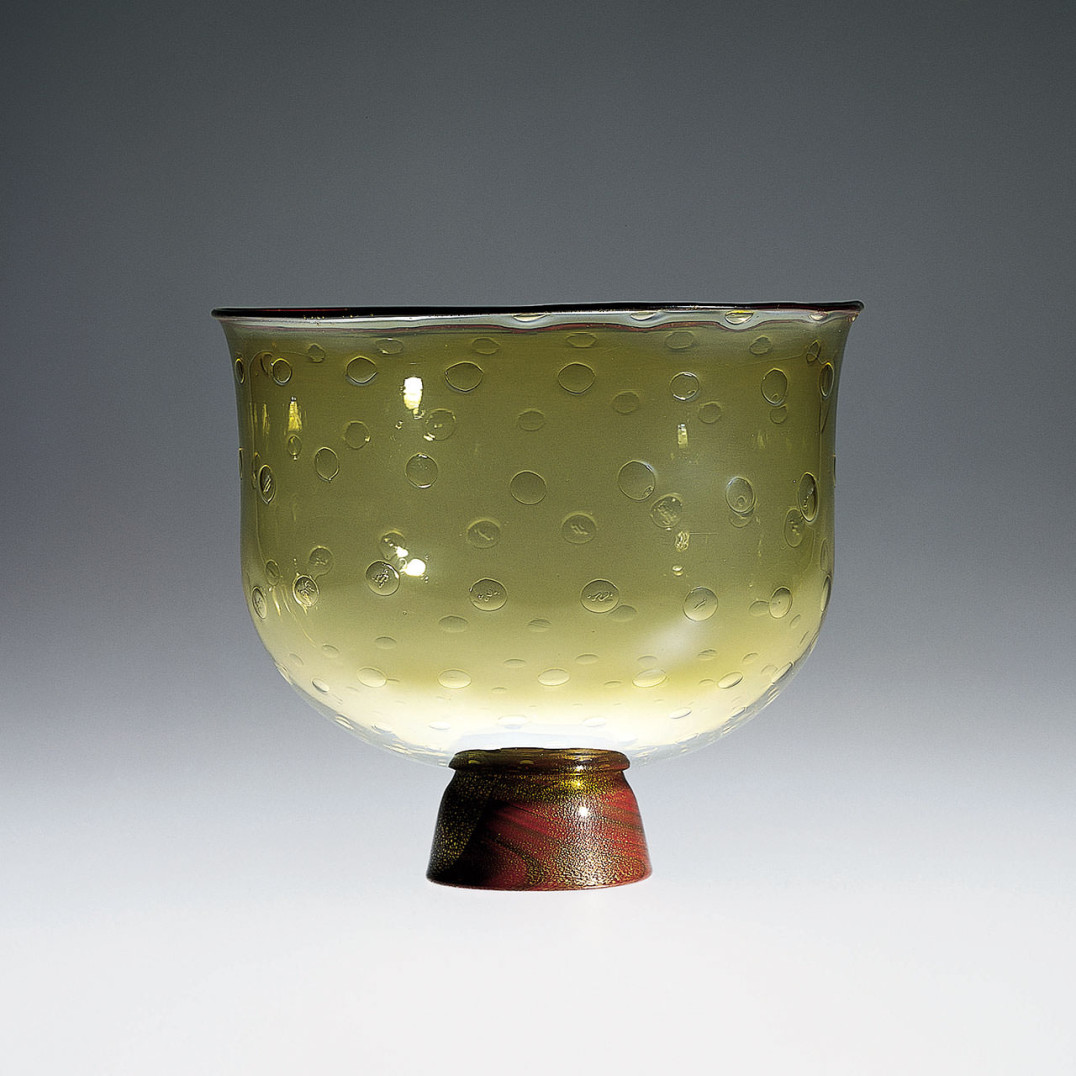
Carlo ScarpaTrasparente, 1930-1931

Carlo ScarpaTrasparenteMaestri Vetrai Muranesi Cappellin & C., 1930-1931
Straw-colored bowl composed of thin glass decorated with large bubbles. Foot and trim in red pasta vitrea with application of gold leaf.
Acid stamped:
M.V.M. Cappellin Murano.
6 3/4 in. high (17.2 cm)
Ø; 7 3/4 in. (19.7 cm)
Exhibitions:
1930, Monza, 4th Esposizione Internazionale delle Arti Decorative e Industriali Moderne;
1931, Amsterdam, Exhibition of modern Italian glass, ceramic, and artistic lacework, Stedelijk Museum;
2000, New York, Venetian Glass, Museum of Arts & Design;
2001, Milan, Murano: Vetri dalla Collezione Olnick Spanu, Spazio Oberdan.
Bibliography and comparative texts:
G. Dell’Oro, 1931, p. 563;
Mostra di vetri…, 1931, p. 19;
Domus, 1933, October, pp. 527-529;
R. Barovier Mentasti, 1982, p. 260;
Mille anni…, 1982, p. 262;
Vetri Murano…, 1982, p. 26;
Vetri di Murano…, 1982, n. 106;
F. Deboni, 1996, p. 34;
M. Barovier, 1997, p. 192;
M. Barovier, 1998 (a), p. 6;
M. Barovier, 1999, p. 114;
Olnick Spanu, 2000, n. 17;
Olnick Spanu, 2001, n. 30.
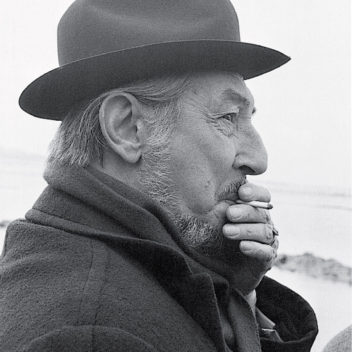
Carlo Scarpa 1906–1978
Born in Venice, Carlo Scarpa graduated from the Accademia di Belle Arti in Venice in 1926. Soon after his graduation he began work at M.V.M. Cappellin, where he soon replaced Vittorio Zecchin as artistic director. Following the direction laid down by Zecchin, he initially created transparent blown-glass pieces with essential forms, in particular the pieces exemplified by their conic base. Scarpa later designed light glass pieces in brightly colored pasta vitrea, or decorated fenici. Deservedly famous was the refined collection of lattimi decorated with gold or silver leaf, which he presented for the first time in Monza in 1930 together with the canne verticali and millefiori glass works. Giacomo Cappellin closed the workshop in 1932 for bankruptcy, putting an end to the collaboration with Carlo Scarpa. In 1934, Scarpa became the artistic director of Venini & C., where he continued to work through 1947. Alongside Paolo Venini, who often participated in the design of glass, Carlo Scarpa experimented with the vast potential of glass, using and innovating many traditional techniques, by which he created extraordinary modern pieces. After the mezza filigrana glass works came the sommersi, the pasta vitrea inspired by Chinese ceramic motifs, the corrosi, the battuti, the vessels a fasce colorate, a pennellate, the variegati, and the famous multicolored murrine with the surfaces finished at the carving wheel. After World War II, Carlo Scarpa worked almost exclusively as an architect and teacher.
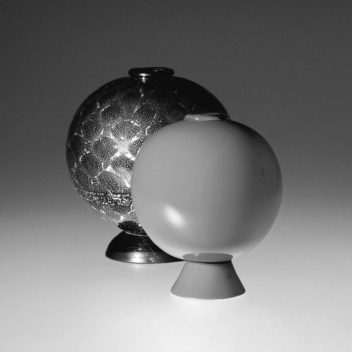
Maestri Vetrai Muranesi Cappellin & C. 1925–1932
M.V.M. Cappellin & C. was founded in 1925 by Giacomo Cappellin after the closing of Cappellin Venini & C. Vittorio Zecchin, a painter from Murano who had worked for Cappellin Venini, continued his collaboration with Cappellin for a short time, designing soffiati, blown glass pieces characterized by delicate colors and pure lines. At the end of 1926, following Zecchin's departure, the young Carlo Scarpa took over the artistic direction of the company. Initially, he proceeded along the course taken by his predecessor, creating lightweight blown pieces with simple geometric forms. These were followed by many collections of refined elegance characterized by various transparent textures and often distinguished by vivid colors. Despite the remarkable success at the 1930 Biennale di Monza, M.V.M. Cappellin & C. was forced to close in January 1932. This was most likely the result of inefficient financial management.
Carlo ScarpaTrasparente, 1930-1931
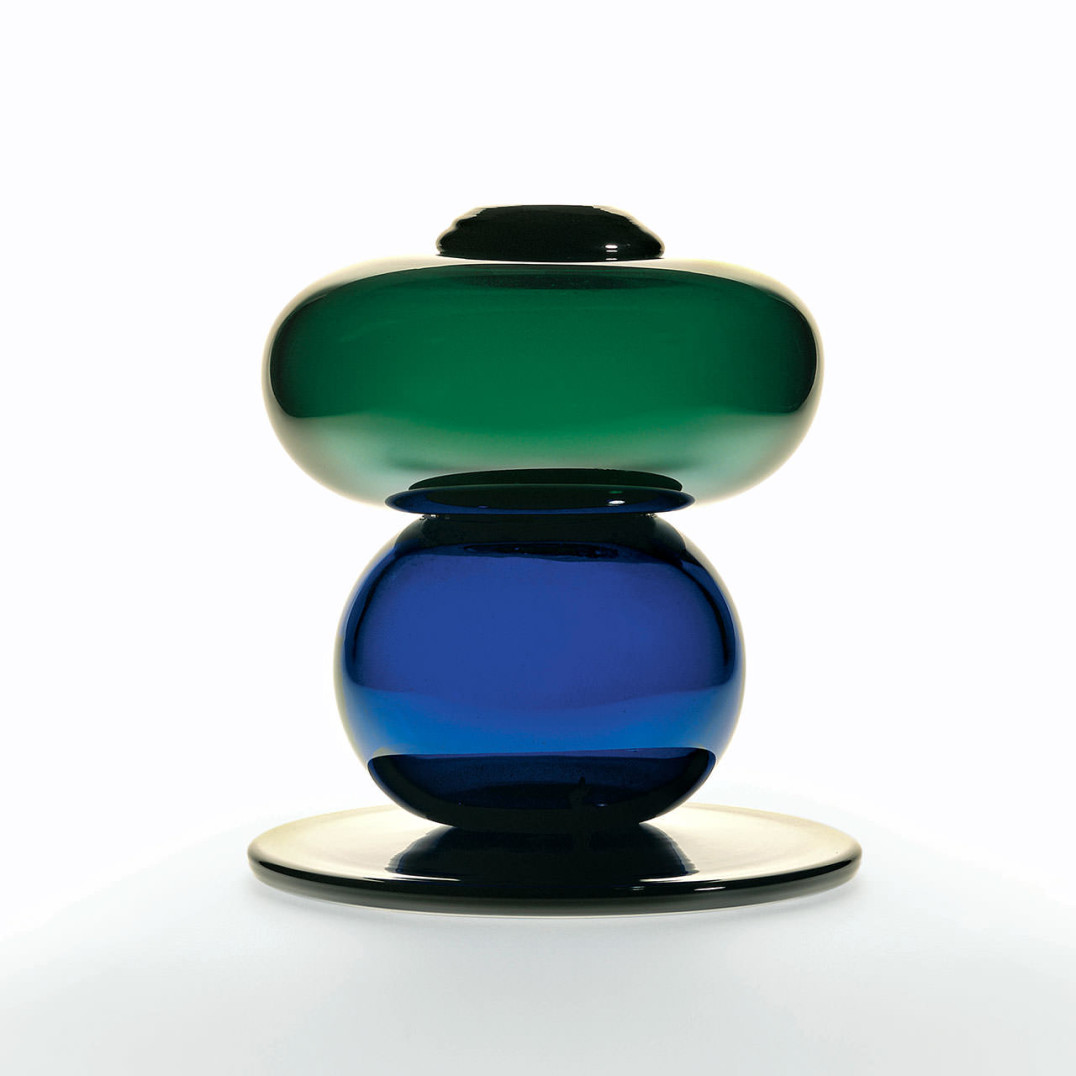
Ettore SottsassMorosina, 1974
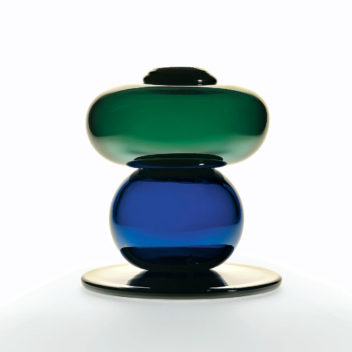
Ettore SottsassMorosinaVetreria Vistosi, 1974
Vessel with elements in blue and green trasparent glass with trim in black glass.
Engraved: Sottsass /250 Vistosi.
11 3/4 in. high (29.8 cm)
Exhibitions:
2001, Milan, Murano: Vetri dalla Collezione Olnick Spanu, Spazio Oberdan.
Bibliography and comparative texts:
M. Cousins, 1995, p. 100;
M. Barovier, B. Bischofberger,
M. Carboni, 1998, p. 17;
M. Romanelli, 2000, p. 191;
Olnick Spanu, 2001, n. 194;
A. Dorigato, 2002, p. 354.
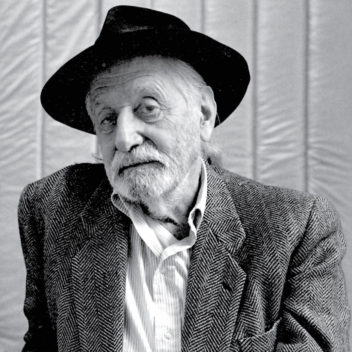
Ettore Sottsass 1917–2007
Born in Innsbruck, Austria, Ettore Sottsass graduated in architecture at the Turin Politecnico in 1939. In 1946 he settled in Milan and began to work in graphics and illustration. A few years later he opened his own studio. From 1949 to 1954 he designed and built several public housing projects in Turin. He was invited to participate in several editions of the Triennale. In 1958, he became a consultant for Poltronova and Olivetti, the company for which he designed the first Italian calculator, Elea 9003, which won him one of the four Compasso d'Oro awards (1959 edition) he collected during his twenty-year collaboration with the company. For Olivetti he designed office machines and typewriters such as Praxis, Tekne, and Valentine, objects whose design quality put them into the permanent collections of museums such as the Museum of Modern Art in New York and the Centre Pompidou in Paris. In 1981, he opened the Studio Sottsass Associati, working in the fields of architecture, graphics, and industrial design. Together with Marco Zanini, he founded the Memphis Group, which pursues its objective of creating a radical iconographical update in figurative language. For Memphis, Sottsass designed furniture, lamps, and accessories, including a series of multicolored glass pieces made of elements crafted by Toso Vetri d'Arte (1982-1986). His preceding experience with glass dated back to 1974, when he designed a series of objects for Vetreria Vistosi. His interest in glass led him to design several pieces for Venini in the '90s and several limited series of works in glass for the Galleria Marina Barovier.
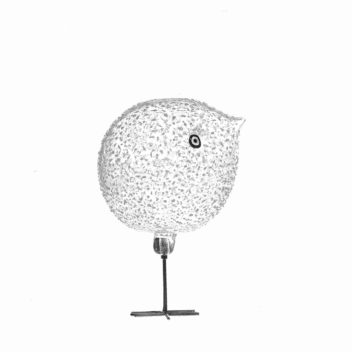
Vetreria Vistosi 1945–1990
The descendant of a family who had been Murano glassmakers for hundreds of years, Guglielmo Vistosi opened the Vistosi furnace in 1945 to produce glass components for lighting. After his death in 1952, the direction of the company was taken over by his brother Oreste and his nephews Gino and Luciano. They carried on the line of production, serving as designers as well. Vistosi also sought the collaboration of many independent artists and professionals such as Alessandro Pianon, Peter Pelzel, and Fulvio Bianconi. During the '60s, the company, successful for its essential forms and the sobriety of its colors, received many awards. During the following decade, its pieces were designed by Angelo Mangiarotti, Enrico Capuzzo, Gae Aulenti, Vico Magistretti, Elenore Peduzzi Riva, and Ettore Sottsass Jr. After the company's change of ownership, the furnace produced glass components for lighting until it was closed in the early '90s.
Ettore SottsassMorosina, 1974
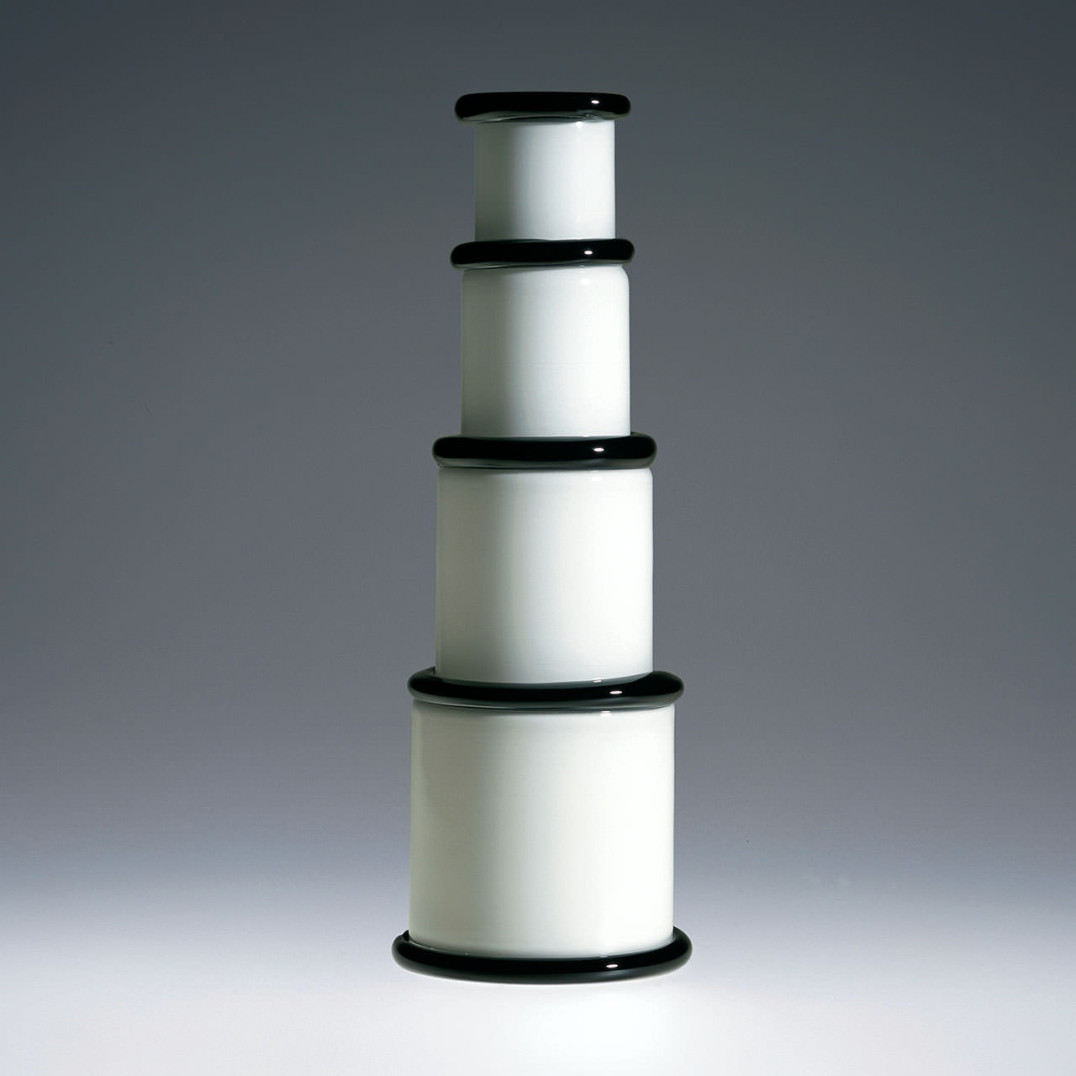
Ettore SottsassMorosina, 1974

Ettore SottsassMorosinaVetreria Vistosi, 1974
Vase in lattimo glass with trim in black glass.
Engraved: E. Sottsass 149/250 Vistosi.
15 1/2 in. high. (39.4 cm)
Exhibitions:
2001, Milan, Murano: Vetri dalla Collezione Olnick Spanu, Spazio Oberdan.
Bibliography and comparative texts:
M. Barovier, B. Bischofberger,
M. Carboni, 1998, pp. 14, 16;
M. Barovier, 1999, p. 290;
Olnick Spanu, 2001, n. 193.

Ettore Sottsass 1917–2007
Born in Innsbruck, Austria, Ettore Sottsass graduated in architecture at the Turin Politecnico in 1939. In 1946 he settled in Milan and began to work in graphics and illustration. A few years later he opened his own studio. From 1949 to 1954 he designed and built several public housing projects in Turin. He was invited to participate in several editions of the Triennale. In 1958, he became a consultant for Poltronova and Olivetti, the company for which he designed the first Italian calculator, Elea 9003, which won him one of the four Compasso d'Oro awards (1959 edition) he collected during his twenty-year collaboration with the company. For Olivetti he designed office machines and typewriters such as Praxis, Tekne, and Valentine, objects whose design quality put them into the permanent collections of museums such as the Museum of Modern Art in New York and the Centre Pompidou in Paris. In 1981, he opened the Studio Sottsass Associati, working in the fields of architecture, graphics, and industrial design. Together with Marco Zanini, he founded the Memphis Group, which pursues its objective of creating a radical iconographical update in figurative language. For Memphis, Sottsass designed furniture, lamps, and accessories, including a series of multicolored glass pieces made of elements crafted by Toso Vetri d'Arte (1982-1986). His preceding experience with glass dated back to 1974, when he designed a series of objects for Vetreria Vistosi. His interest in glass led him to design several pieces for Venini in the '90s and several limited series of works in glass for the Galleria Marina Barovier.

Vetreria Vistosi 1945–1990
The descendant of a family who had been Murano glassmakers for hundreds of years, Guglielmo Vistosi opened the Vistosi furnace in 1945 to produce glass components for lighting. After his death in 1952, the direction of the company was taken over by his brother Oreste and his nephews Gino and Luciano. They carried on the line of production, serving as designers as well. Vistosi also sought the collaboration of many independent artists and professionals such as Alessandro Pianon, Peter Pelzel, and Fulvio Bianconi. During the '60s, the company, successful for its essential forms and the sobriety of its colors, received many awards. During the following decade, its pieces were designed by Angelo Mangiarotti, Enrico Capuzzo, Gae Aulenti, Vico Magistretti, Elenore Peduzzi Riva, and Ettore Sottsass Jr. After the company's change of ownership, the furnace produced glass components for lighting until it was closed in the early '90s.
Ettore SottsassMorosina, 1974
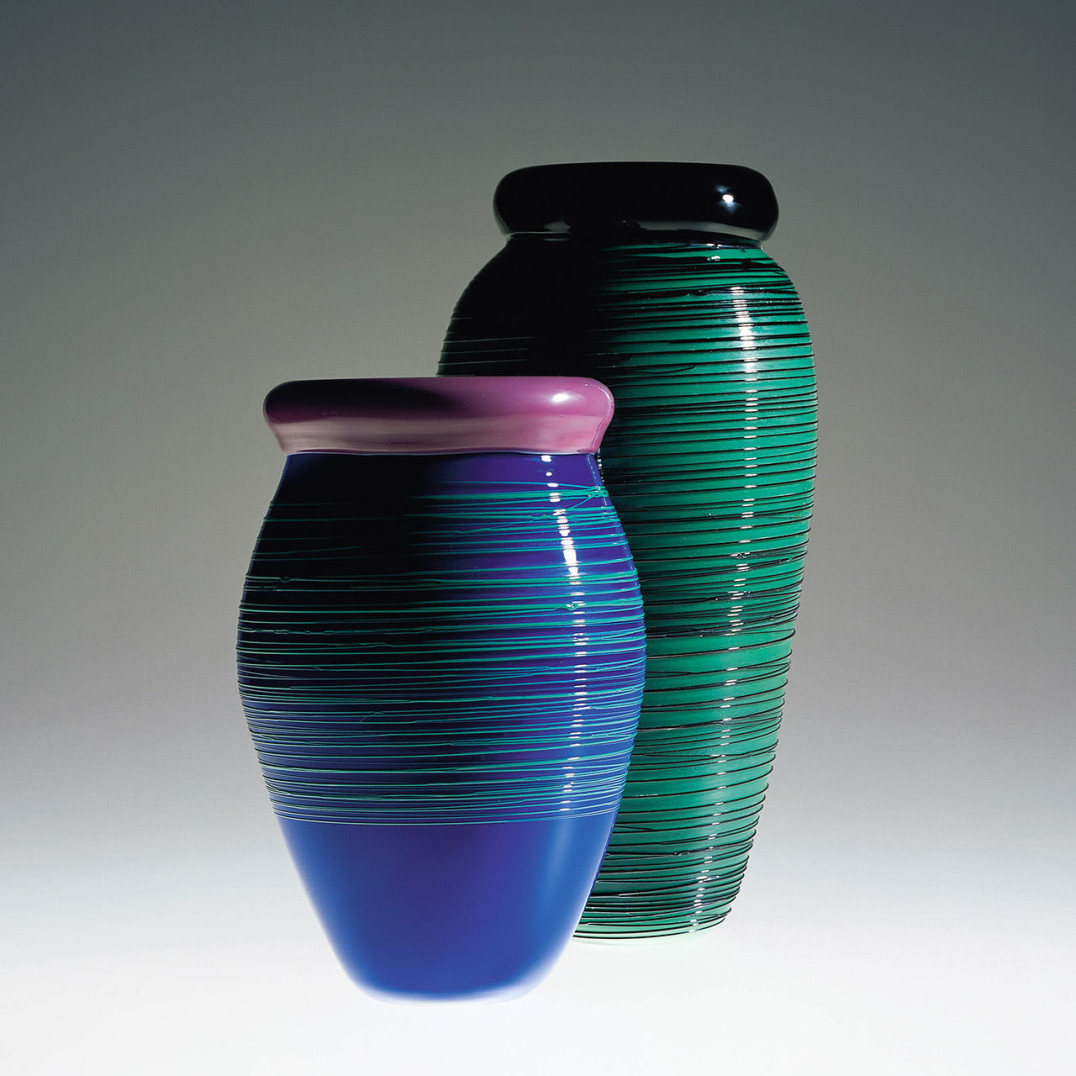
Mary Ann ZynskyChiacchere, 1984
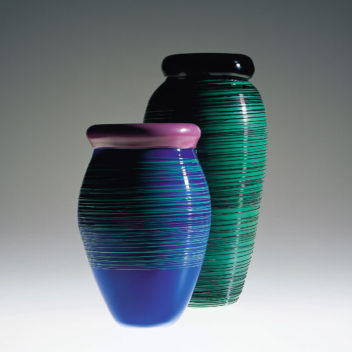
Mary Ann ZynskyChiacchereVenini & C., 1984
Two vases called Chiacchere but also known as Mulinello. The one on the left is composed of pink glass cased in blue with a pink mouth and applied green threads. The one on the right is in black glass cased in green with a black mouth and applied black threads.
Engraved: Zinsky x Venini 1984.
10 in. high (25.4 cm)
14 in. high (35.5 cm)
Exhibitions:
2000, New York, Venetian Glass, Museum of Arts & Design;
2001, Milan, Murano: Vetri dalla Collezione Olnick Spanu, Spazio Oberdan.
Bibliography and comparative texts:
G. Duplani Tucci, 1989, n. 67;
R. Barovier Mentasti, 1992, n. 163;
Glas Band II, 1992, p. 128;
A. Venini Diaz de Santillana, 1996, n. 263;
A. Venini Diaz de Santillana, 2000, n. 270; Olnick Spanu, 2000, n. 153;
Olnick Spanu, 2001, n. 192.
A turquoise bowl cased in lattimo glass decorated with a random design of pink and pale blue threads.
Engraved: Zinsky x Venini 1984.
7 1/4 in. high (18.5 cm)
Bibliography and comparative texts:
R. Linzeler, 1922, p. 666;
C. Carrà , 1923, p. 67;
R. Linzeler, 1923, p. 83;
R. Papini, 1930, n. 570;
G. Mariacher, 1967, p. 98;
R. Barovier Mentasti, 1982, n. 252;
Mille anni…, 1982, n. 503;
F. Deboni, 1984, p. n. 70;
W. Neuwirth, 1987, nn. 7, 104;
A. Dorigato, 1986,
p. 71;
F. Deboni, 1989, n. 1;
L’arte del vetro, 1982, n. 307;
M. Heiremans, 1993, n. 191;
M. Barovier, R. Barovier Mentasti,
A. Dorigato, 1995, n. 15;
A. Venini Diaz de Santillana, 1996, n. 1;
R. Barovier Mentasti, 1998, n. 25;
A. Venini Diaz de Santillana, 2000, n. 1;
Olnick Spanu, 2000, n. 8;
Olnick Spanu, 2001, n. 13.
A green vase decorated with a random design of orange threads.
Engraved: Zinsky x Venini 1984.
12 1/2 in. high (31.5 cm)
Bibliography and comparative texts:
R. Linzeler, 1922, p. 666;
C. Carrà , 1923, p. 67;
R. Linzeler, 1923, p. 83;
R. Papini, 1930, n. 570;
G. Mariacher, 1967, p. 98;
R. Barovier Mentasti, 1982, n. 252;
Mille anni…, 1982, n. 503;
F. Deboni, 1984, p. n. 70;
W. Neuwirth, 1987, nn. 7, 104;
A. Dorigato, 1986,
p. 71;
F. Deboni, 1989, n. 1;
L’arte del vetro, 1982, n. 307;
M. Heiremans, 1993, n. 191;
M. Barovier, R. Barovier Mentasti,
A. Dorigato, 1995, n. 15;
A. Venini Diaz de Santillana, 1996, n. 1;
R. Barovier Mentasti, 1998, n. 25;
A. Venini Diaz de Santillana, 2000, n. 1;
Olnick Spanu, 2000, n. 8;
Olnick Spanu, 2001, n. 13.
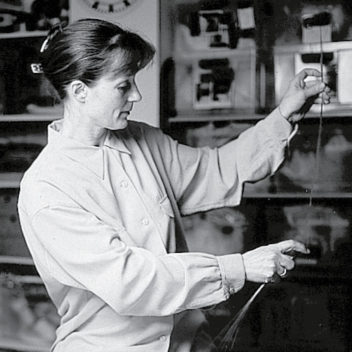
Mary Ann Zynsky 1951–
Designer Mary Ann "Toots" Zynsky was born in Boston and attended the Rhode Island School of Design, the Pilchuck Glass School, and the Craft School at Haystack, taking part in various experiences and experiments. From 1981 to 1983, she collaborated with Venini, where, with the help of maestro Checco Ongaro, she created a remarkable series of pieces. Among these are the vessels called Folto, whose openings have wide turned-over lips, and decorations with glass rods produced out of hair-thin threads made with a technique she invented herself. Her works are present not only in the major international museums, but also in the White House amidst the works of the best American artists.

Venini & C. 1932–2001
In 1932, when both Martinuzzi and Zecchin left the company, Paolo Venini changed the name from Vetri Soffiati Muranesi Venini & Co. (V.S.M. Venini & Co.) to Venini & C.. Milanese architect Tommaso Buzzi became the new artistic director. After 1934, artistic direction was taken on by Carlo Scarpa, who designed most of the company's production through 1947. Side by side with Venini, who often intervened personally in design, Scarpa created numerous collections of objects characterized by refined colors. After World War II, Venini & C. sought numerous collaborations with artists such as architect Giò Ponti and the Swedish-born Tyra Lundgren. After 1948, Fulvio Bianconi, Massimo Vignelli, and Tobia Scarpa contributed significantly to the new direction of the company. Paolo Venini died in 1959 and his son-in-law, Ludovico Diaz de Santillana, took over the management of Venini & C. He not only worked personally as a glass designer but also continued the collaboration started by Paolo Venini with various artists and designers. Starting in 1960, many other designers collaborated with the company, like Thomas Stearns, Toni Zuccheri, Tapio Wirkkala, Laura and Alessandro Diaz de Santillana, James Carpenter, Dan Dailey, Richard Marquis, Benjamin Moore, and Toots Zynsky. In 1986, the de Santillana family left the company, selling their stock to the Ferruzzi group, which guaranteed the fine quality Venini was known for by hiring new designers such as Timo Sarpaneva, Marco Zanini, Ettore Sottsass Jr., Alessandro Mendini, Mario Bellini, Barbara del Vicario, and others. In 1988, Venini was acquired by Royal Scandinavian. Since 2001, Venini S.p.A. has been part of Italian Luxury Industries Group and is led by Giancarlo Chimento, Giuliano Tabacchi, and Giorgio Rizzo.
Mary Ann ZynskyChiacchere, 1984

Carlo ScarpaTrasparente, 1926-1931
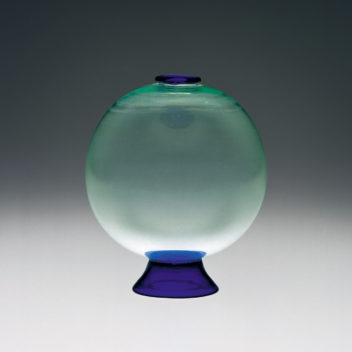
Carlo ScarpaTrasparenteMaestri Vetrai Muranesi Cappellin & C., 1926-1931
Light green globular-shaped vase in blown glass with a conical foot and mouth in blue glass. This vase became the symbol of the M.V.M. Cappellin workshop.
5 1/2 in. high (14 cm)
Exhibitions:
1926, Paris, Salon d’Automne; 1927, Monza, 3rd Mostra Internazionale delle Arti Decorative; 1930, Monza, 4th Mostra Internazionale delle Arti Decorative e Industriali Moderne; 1931, Amsterdam, Exhibition of modern Italian glass, ceramic, and artistic lacework, Stedelijk Museum; 2000, New York, Venetian Glass, Museum of Arts & Design; 2001, Milan, Murano: Vetri dalla Collezione Olnick Spanu, Spazio Oberdan.
Bibliography and comparative texts:
P. du Colombier, 1926, p. 187;
Domus, 1928, December, p. 59;
G. Dell’Oro, 1931, p. 563;
Mostra di vetri…, 1931, p. 19;
Domus, 1933, October, pp. 527, 528, 529;
R. Barovier Mentasti, 1982, p. 260;
Mille anni…, 1982,
p. 262;
Vetri Murano…, 1982, p. 26;
Vetri di Murano…, 1982, n. 106;
F. Deboni, 1996, p. 34;
M. Barovier, 1997, p. 192;
M. Barovier, 1998(b),
p. 6;
M. Barovier, 1999, p. 114;
Olnick Spanu, 2000, n. 18;
Olnick Spanu, 2001, n. 31.

Carlo Scarpa 1906–1978
Born in Venice, Carlo Scarpa graduated from the Accademia di Belle Arti in Venice in 1926. Soon after his graduation he began work at M.V.M. Cappellin, where he soon replaced Vittorio Zecchin as artistic director. Following the direction laid down by Zecchin, he initially created transparent blown-glass pieces with essential forms, in particular the pieces exemplified by their conic base. Scarpa later designed light glass pieces in brightly colored pasta vitrea, or decorated fenici. Deservedly famous was the refined collection of lattimi decorated with gold or silver leaf, which he presented for the first time in Monza in 1930 together with the canne verticali and millefiori glass works. Giacomo Cappellin closed the workshop in 1932 for bankruptcy, putting an end to the collaboration with Carlo Scarpa. In 1934, Scarpa became the artistic director of Venini & C., where he continued to work through 1947. Alongside Paolo Venini, who often participated in the design of glass, Carlo Scarpa experimented with the vast potential of glass, using and innovating many traditional techniques, by which he created extraordinary modern pieces. After the mezza filigrana glass works came the sommersi, the pasta vitrea inspired by Chinese ceramic motifs, the corrosi, the battuti, the vessels a fasce colorate, a pennellate, the variegati, and the famous multicolored murrine with the surfaces finished at the carving wheel. After World War II, Carlo Scarpa worked almost exclusively as an architect and teacher.

Maestri Vetrai Muranesi Cappellin & C. 1925–1932
M.V.M. Cappellin & C. was founded in 1925 by Giacomo Cappellin after the closing of Cappellin Venini & C. Vittorio Zecchin, a painter from Murano who had worked for Cappellin Venini, continued his collaboration with Cappellin for a short time, designing soffiati, blown glass pieces characterized by delicate colors and pure lines. At the end of 1926, following Zecchin's departure, the young Carlo Scarpa took over the artistic direction of the company. Initially, he proceeded along the course taken by his predecessor, creating lightweight blown pieces with simple geometric forms. These were followed by many collections of refined elegance characterized by various transparent textures and often distinguished by vivid colors. Despite the remarkable success at the 1930 Biennale di Monza, M.V.M. Cappellin & C. was forced to close in January 1932. This was most likely the result of inefficient financial management.